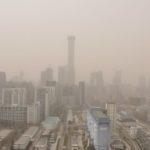 Tackling climate change promises to bring many benefits to society, not least in terms of the health benefits from reduced air pollution. Nonetheless, research from Penn State suggests that these benefits may be swamped by the health impact of an aging population and economic inequality.
Tackling climate change promises to bring many benefits to society, not least in terms of the health benefits from reduced air pollution. Nonetheless, research from Penn State suggests that these benefits may be swamped by the health impact of an aging population and economic inequality.
The researchers used past and projected data to produce five possible scenarios, each of which estimated premature deaths linked to air pollution.
“When we think about the pollution impacts on future populations, exposure to ambient particulate matter—or air pollution—caused by fossil fuel emissions, is the greatest threat to global health,” the researchers explain.
“The health burden is unevenly distributed across countries and disproportionately borne by the global south. To make credible projections of future global health, we created an integrated modeling framework that combines air quality simulations with macro-level sociodemographic drivers like global population and economic development.”
Societal changes
The researchers integrated data from the World Climate Research Program’s Scenario Model Intercomparison Project with the National Oceanic and Atmospheric Administration’s (NOAA) Geophysical Fluid Dynamics Laboratory to gauge how socioeconomic trends coupled with climate mitigation projects may influence air quality.
The model then estimated the exposure to pollution and how this affected premature deaths according to a variety of pollution controls, socioeconomic trends, and climate warming patterns between 2015 and 2100. The results show that across each of the scenarios, countries, and regions that managed to limit emissions had lower pollution concentration.
The results showed, however, that lower levels of pollution were not enough on their own to lower the projected number of deaths. Instead, things like aging and declining baseline mortality were found to be more reliable predictors of premature deaths.
“Emerging markets like China and India contribute to less than half of the global carbon emissions, but they suffer from 60% of the world’s health damage due to air pollution,” the researchers explain. “That is partly because they do not have sufficient end-of-pipe controls, or effective regulations controlling how much emissions industries can release to the air.”
Indeed, the models showed that India and China accounted for the highest numbers of estimated premature deaths, with this probably due to an aging population that is more exposed to pollution.
“Areas with unsatisfying socio-economic conditions and limited access to health care tend to have higher baseline mortality rates,” the authors continue. “If you couple that with an aging population, death rates go up. If we do more to clean the air and put limits on emissions, we have a chance to have a different future, to fight against some of the negative health effects of sociodemographic changes coming our way.”
The researchers hope that their work will better inform the next steps taken by society to try and mitigate the negative impacts of air pollution on population health.
“Understanding the potential pathways of future air pollution and associated health burden using Earth system models is critical for crafting effective mitigation strategies,” they conclude. “This work sheds new light on untangling the impacts of emissions, climate change, exposure levels and socio-demographic factors in determining the future health burden from air pollution.”